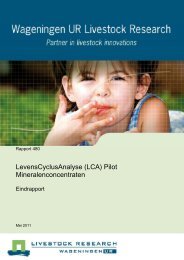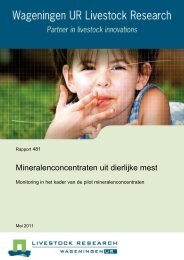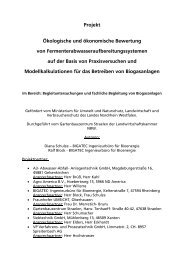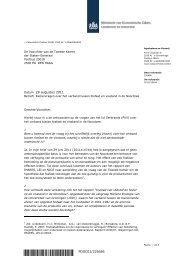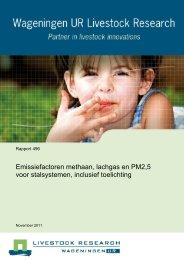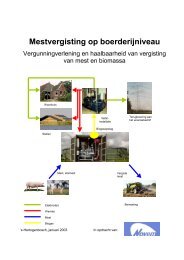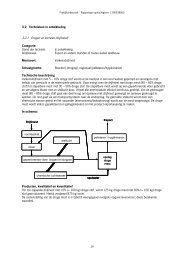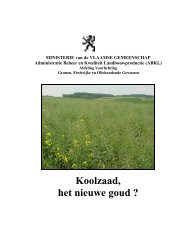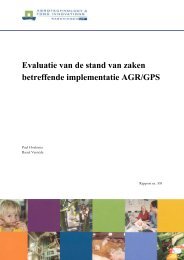Monitoring methane and nitrous oxide reduction by manure treatment
Monitoring methane and nitrous oxide reduction by manure treatment
Monitoring methane and nitrous oxide reduction by manure treatment
You also want an ePaper? Increase the reach of your titles
YUMPU automatically turns print PDFs into web optimized ePapers that Google loves.
Report 627<br />
At the same time, the remaining <strong>manure</strong> can be used as a fertilizer. Biogas production is a very<br />
efficient way to reduce GHG emissions, both via production of renewable energy <strong>and</strong> through<br />
avoidance of emissions from <strong>manure</strong> management. A long digestion time should be taken into account<br />
in order to avoid emissions at storage <strong>and</strong> from soil applications afterwards (Clemens et al., 2006).<br />
Storage<br />
Anaerobic digestion leads to the production of biogas <strong>and</strong> digested <strong>manure</strong>. Due to the digestion<br />
process, the composition of the digested <strong>manure</strong> differs from the composition of untreated <strong>manure</strong>:<br />
Digested <strong>manure</strong> has generally a higher mineral nitrogen content <strong>and</strong> a lower organic nitrogen<br />
content compared to untreated <strong>manure</strong> (Birkmose, 2000; Bosker & Kool, 2004; Clemens &<br />
Huschka, 2001; Clemens et al., 2006; Hansen et al., 2006; Kirchmann & Lundvall, 1998; Kool,<br />
2006; Mosquera & Hol, 2007; Sommer & Husted, 1995; Sommer et al., 2004b, 2006;<br />
Timmerman et al., 2005b; Wulf et al., 2002a,b). However, De Boer (2004) found no<br />
+<br />
differences in NH4 -N between digested <strong>and</strong> untreated <strong>manure</strong>, <strong>and</strong> Velthof et al. (2002) found<br />
both an increase <strong>and</strong> a decrease in the mineral nitrogen content of co-digested <strong>manure</strong><br />
compared to untreated <strong>manure</strong>, depending on the co-substrates used in the process.<br />
Results about total nitrogen content are not consistent. In some cases, no differences are<br />
observed (Birkmose, 2000; Clemens et al., 2006), sometimes a higher total nitrogen content<br />
has been observed in digested <strong>manure</strong> compared to untreated <strong>manure</strong> (Hansen et al., 2006;<br />
Sommer et al., 2004b, 2006; Timmerman et al., 2005b; Velthof et al., 2002), but also lower<br />
contents have been observed (De Boer, 2004; Kool, 2006; Velthof et al., 2002; Wulf et al.,<br />
2002a,b) after digestion.<br />
The pH of <strong>manure</strong> increases after digestion (Birkmose, 2000; Clemens & Huschka, 2001;<br />
Clemens et al., 2006; De Boer, 2004; Hansen et al., 2006; Mosquera & Hol, 2007; Pain et al.,<br />
1990a; Rubaek et al., 1996; Sommer & Husted, 1995; Sommer et al., 2004b, 2006;<br />
Timmerman et al., 2005b; Velthof et al., 2002, Wulf et al., 2002a,b).<br />
The dry matter content of digested <strong>manure</strong> is normally lower than of untreated <strong>manure</strong><br />
(Birkmose, 2000; Clemens et al., 2006; De Boer, 2004; Hansen et al., 2006; Kool, 2006;<br />
Mosquera & Hol, 2007; Pain et al., 1990a; Sommer & Olesen, 1991; Sommer et al., 2004b,<br />
2006; Timmerman et al., 2005b; Velthof et al., 2002; Wulf et al., 2002a,b). However, Sommer<br />
et al. (2004b) found no differences in dry matter content between digested <strong>and</strong> untreated<br />
<strong>manure</strong>, <strong>and</strong> Clemens & Hutschka (2001) reported even higher dry matter contents after<br />
digestion.<br />
Amon et al. (2006) found lower CH4 emissions from digested <strong>manure</strong> (67% <strong>reduction</strong>) but 41% higher<br />
N2O emissions compared to untreated cattle slurry during storage. Total greenhouse gas emissions<br />
from storage of digested slurry were reduced <strong>by</strong> 59% compared to untreated <strong>manure</strong>. Clemens et al.<br />
(2006) reported 32-68% lower CH4 <strong>and</strong> lower (9%) or higher (49%) N2O emissions from digested<br />
cattle <strong>manure</strong> compared to untreated <strong>manure</strong>. Total greenhouse gas emissions were reduced <strong>by</strong> 14-<br />
48%. Sommer et al. (2000) also reported higher N2O emissions (<strong>by</strong> 26%) from digested cattle slurry<br />
than from untreated cattle slurry.<br />
Clemens et al.<br />
(2006)<br />
15<br />
N 2O CH 4 GHG<br />
Crust_winter 9% 32% 14%<br />
Crust_summer 49% 68% 48%<br />
Amon et al. (2006) Wooden lid 41% 67% 59%





